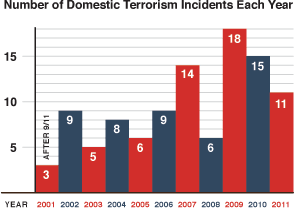| |
 INITIATIVE
INITIATIVE
Domestic Terrorism Post-9/11 (2001-2011)
During the ten years following September 11th, 2001 there were over 100 incidents of "home-grown" or domestic terrorism in the United States. To provide a valuable resource on this topic, the Crime Commission has compiled an extensive database of incidents including attacks, plots, support for, membership in, or connections with a terrorist organization. While information about terrorist incidents are available elsewhere, both on and off the Internet, the Crime Commission's database is unique in providing a centralized, concise, user-friendly, and visually engaging informational resource on domestic terrorism. read more »
| |
Sept-Nov 2001
Princeton, NJ
Bruce Ivins
Attack: Biological Weapon
|
Amerithrax: U.S. citizen mails letters filled with anthrax across the country
In the weeks after 9/11, a series of letters filled with anthrax were delivered across the country through the U.S. Postal Service. The letters, dropped into a mailbox in Princeton, NJ, were addressed to the New York Post, NBC's Tom Brokaw, Senator Tom Daschle and Senator Patrick Leahy. Because of cross-contamination of the mail cases of anthrax were also reported at other locations, including American Media in Florida, and at the New York offices of CBS and ABC, although the FBI does not believe letters were sent to these offices. The letters forced the evacuation of Congressional offices and the Supreme Court, and disrupted mail service for weeks.
The FBI believes U.S. Army Medical Research Institute of Infectious Diseases microbiologist Bruce Ivins, a U.S. citizen, perpetrated the attacks to reenergize the failing anthrax vaccine program he was working on at the time. Initially authorities believed the attacks were by Al Qaeda because of attached notes expressing anti-American and anti-Israeli sentiments. Upon identifying the strain of anthrax used, the FBI concluded the attacks were domestic and likely the work of a "bioevangelist", or someone who wanted to alert the country to the dangers of a biological attack. The eight-year investigation first focused on another scientist, Dr. Steven Hatfill, as the prime suspect until authorities officially exonerated him in 2008. Suspicion of Ivins grew as the investigation continued, but it was not until November 2007 that Ivins lost his security clearance at Fort Detrick and became a prime suspect.
At least 22 people contracted anthrax as a result of the incidents, and 5 died. Before the case could progress further, Ivins committed suicide on July 29, 2008. The FBI officially closed the investigation on February 19, 2010, concluding that Ivins was the anthrax mailer. Although an independent panel of psychiatrists reviewed Ivins' medical records finding evidence in support of the FBI's conclusion, other scientists remain uncertain whether the case should be considered closed.
|
|
| |
November 2001
Afghanistan
John Walker Lindh
Support: Personnel
Al Qaeda
|
"American Taliban": U.S. citizen joins Al Qaeda
A U.S. citizen who converted to Islam in his teens, John Walker Lindh, 20 when captured, attended Al Qaeda training camps, pledged support to Osama bin Laden and worked as a foot soldier for the Taliban. American-supported troops captured John Walker Lindh fighting with the Taliban in Afghanistan in late November 2001.
Lindh confessed he fought in several battles against American troops and was present during an Afghan Northern Alliance prison riot that left a CIA officer dead. Lindh was indicted in the U.S. District Court for the Eastern District of Virginia on February 4, 2002, for conspiracy to kill Americans, conspiracy to aid a terrorist organization and using a firearm during a violent crime. Treason was not included in the indictment, which could have resulted in the death penalty.
Lindh pleaded guilty on July 15, 2002; he was sentenced to 20 years in prison on October 4, 2002.
|
|
| |
December 12, 2001
Peoria, IL
Ali Saleh Kahlah al-Marri
Support: Material
Al Qaeda
Jose Padilla
|
Enemy Combatant: Student in Illinois with numerous links to Al Qaeda
On December 12, 2001, Ali Saleh Kahlah al-Marri, a Qatari citizen and legal U.S. resident with a student visa, was arrested in Peoria, IL, where he was studying computer science at Bradley University. Prior to his arrival in the U.S. on September 10, 2001, he had reportedly attended a terrorist training camp, met with Osama bin Laden, pledged support to Al Qaeda and offered to set up agents in the U.S. for future attacks. Prosecutors claimed that he was associated with Al Qaeda and attempted to support the organization through credit card fraud. After his arrest he was held as a material witness in the 9/11 attacks at the request of federal prosecutors in New York. He was indicted in federal court two months later on charges of credit card fraud.
After further evidence arose linking him to Al Qaeda, he was removed from the federal criminal justice system and placed under military jurisdiction, when President George W. Bush designated him an "enemy combatant" on June 23, 2003. He spent more than five years in military custody until February 27, 2009, when President Barack Obama ordered his return to the custody of the federal criminal justice system.
Al-Marri accepted a plea bargain on April 30, 2009, pleading guilty to one count of providing support to a terrorist organization. He was sentenced in the U.S. District Court for the Central District of Illinois to eight years and four months in prison on October 29, 2009; the judge dropped six years and eight months from the prosecution's recommended sentence because of the time al-Marri was held in isolation by the military and the harsh conditions of his imprisonment at the U.S. naval brig (military prison) in Charleston, SC.
|
|
|
|

 INITIATIVE
INITIATIVE